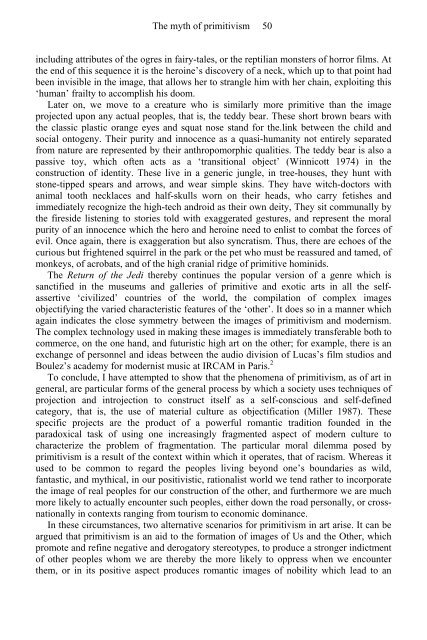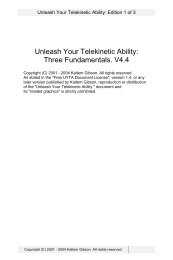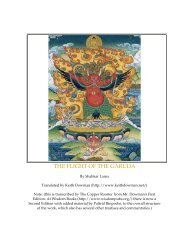Hiller - The Myth of Primitivism. Perspectives on Art - Esoteric Online
Hiller - The Myth of Primitivism. Perspectives on Art - Esoteric Online
Hiller - The Myth of Primitivism. Perspectives on Art - Esoteric Online
You also want an ePaper? Increase the reach of your titles
YUMPU automatically turns print PDFs into web optimized ePapers that Google loves.
<str<strong>on</strong>g>The</str<strong>on</strong>g> myth <str<strong>on</strong>g>of</str<strong>on</strong>g> primitivism 50<br />
including attributes <str<strong>on</strong>g>of</str<strong>on</strong>g> the ogres in fairy-tales, or the reptilian m<strong>on</strong>sters <str<strong>on</strong>g>of</str<strong>on</strong>g> horror films. At<br />
the end <str<strong>on</strong>g>of</str<strong>on</strong>g> this sequence it is the heroine’s discovery <str<strong>on</strong>g>of</str<strong>on</strong>g> a neck, which up to that point had<br />
been invisible in the image, that allows her to strangle him with her chain, exploiting this<br />
‘human’ frailty to accomplish his doom.<br />
Later <strong>on</strong>, we move to a creature who is similarly more primitive than the image<br />
projected up<strong>on</strong> any actual peoples, that is, the teddy bear. <str<strong>on</strong>g>The</str<strong>on</strong>g>se short brown bears with<br />
the classic plastic orange eyes and squat nose stand for the.link between the child and<br />
social <strong>on</strong>togeny. <str<strong>on</strong>g>The</str<strong>on</strong>g>ir purity and innocence as a quasi-humanity not entirely separated<br />
from nature are represented by their anthropomorphic qualities. <str<strong>on</strong>g>The</str<strong>on</strong>g> teddy bear is also a<br />
passive toy, which <str<strong>on</strong>g>of</str<strong>on</strong>g>ten acts as a ‘transiti<strong>on</strong>al object’ (Winnicott 1974) in the<br />
c<strong>on</strong>structi<strong>on</strong> <str<strong>on</strong>g>of</str<strong>on</strong>g> identity. <str<strong>on</strong>g>The</str<strong>on</strong>g>se live in a generic jungle, in tree-houses, they hunt with<br />
st<strong>on</strong>e-tipped spears and arrows, and wear simple skins. <str<strong>on</strong>g>The</str<strong>on</strong>g>y have witch-doctors with<br />
animal tooth necklaces and half-skulls worn <strong>on</strong> their heads, who carry fetishes and<br />
immediately recognize the high-tech android as their own deity, <str<strong>on</strong>g>The</str<strong>on</strong>g>y sit communally by<br />
the fireside listening to stories told with exaggerated gestures, and represent the moral<br />
purity <str<strong>on</strong>g>of</str<strong>on</strong>g> an innocence which the hero and heroine need to enlist to combat the forces <str<strong>on</strong>g>of</str<strong>on</strong>g><br />
evil. Once again, there is exaggerati<strong>on</strong> but also syncratism. Thus, there are echoes <str<strong>on</strong>g>of</str<strong>on</strong>g> the<br />
curious but frightened squirrel in the park or the pet who must be reassured and tamed, <str<strong>on</strong>g>of</str<strong>on</strong>g><br />
m<strong>on</strong>keys, <str<strong>on</strong>g>of</str<strong>on</strong>g> acrobats, and <str<strong>on</strong>g>of</str<strong>on</strong>g> the high cranial ridge <str<strong>on</strong>g>of</str<strong>on</strong>g> primitive hominids.<br />
<str<strong>on</strong>g>The</str<strong>on</strong>g> Return <str<strong>on</strong>g>of</str<strong>on</strong>g> the Jedi thereby c<strong>on</strong>tinues the popular versi<strong>on</strong> <str<strong>on</strong>g>of</str<strong>on</strong>g> a genre which is<br />
sanctified in the museums and galleries <str<strong>on</strong>g>of</str<strong>on</strong>g> primitive and exotic arts in all the selfassertive<br />
‘civilized’ countries <str<strong>on</strong>g>of</str<strong>on</strong>g> the world, the compilati<strong>on</strong> <str<strong>on</strong>g>of</str<strong>on</strong>g> complex images<br />
objectifying the varied characteristic features <str<strong>on</strong>g>of</str<strong>on</strong>g> the ‘other’. It does so in a manner which<br />
again indicates the close symmetry between the images <str<strong>on</strong>g>of</str<strong>on</strong>g> primitivism and modernism.<br />
<str<strong>on</strong>g>The</str<strong>on</strong>g> complex technology used in making these images is immediately transferable both to<br />
commerce, <strong>on</strong> the <strong>on</strong>e hand, and futuristic high art <strong>on</strong> the other; for example, there is an<br />
exchange <str<strong>on</strong>g>of</str<strong>on</strong>g> pers<strong>on</strong>nel and ideas between the audio divisi<strong>on</strong> <str<strong>on</strong>g>of</str<strong>on</strong>g> Lucas’s film studios and<br />
Boulez’s academy for modernist music at IRCAM in Paris. 2<br />
To c<strong>on</strong>clude, I have attempted to show that the phenomena <str<strong>on</strong>g>of</str<strong>on</strong>g> primitivism, as <str<strong>on</strong>g>of</str<strong>on</strong>g> art in<br />
general, are particular forms <str<strong>on</strong>g>of</str<strong>on</strong>g> the general process by which a society uses techniques <str<strong>on</strong>g>of</str<strong>on</strong>g><br />
projecti<strong>on</strong> and introjecti<strong>on</strong> to c<strong>on</strong>struct itself as a self-c<strong>on</strong>scious and self-defined<br />
category, that is, the use <str<strong>on</strong>g>of</str<strong>on</strong>g> material culture as objectificati<strong>on</strong> (Miller 1987). <str<strong>on</strong>g>The</str<strong>on</strong>g>se<br />
specific projects are the product <str<strong>on</strong>g>of</str<strong>on</strong>g> a powerful romantic traditi<strong>on</strong> founded in the<br />
paradoxical task <str<strong>on</strong>g>of</str<strong>on</strong>g> using <strong>on</strong>e increasingly fragmented aspect <str<strong>on</strong>g>of</str<strong>on</strong>g> modern culture to<br />
characterize the problem <str<strong>on</strong>g>of</str<strong>on</strong>g> fragmentati<strong>on</strong>. <str<strong>on</strong>g>The</str<strong>on</strong>g> particular moral dilemma posed by<br />
primitivism is a result <str<strong>on</strong>g>of</str<strong>on</strong>g> the c<strong>on</strong>text within which it operates, that <str<strong>on</strong>g>of</str<strong>on</strong>g> racism. Whereas it<br />
used to be comm<strong>on</strong> to regard the peoples living bey<strong>on</strong>d <strong>on</strong>e’s boundaries as wild,<br />
fantastic, and mythical, in our positivistic, rati<strong>on</strong>alist world we tend rather to incorporate<br />
the image <str<strong>on</strong>g>of</str<strong>on</strong>g> real peoples for our c<strong>on</strong>structi<strong>on</strong> <str<strong>on</strong>g>of</str<strong>on</strong>g> the other, and furthermore we are much<br />
more likely to actually encounter such peoples, either down the road pers<strong>on</strong>ally, or crossnati<strong>on</strong>ally<br />
in c<strong>on</strong>texts ranging from tourism to ec<strong>on</strong>omic dominance.<br />
In these circumstances, two alternative scenarios for primitivism in art arise. It can be<br />
argued that primitivism is an aid to the formati<strong>on</strong> <str<strong>on</strong>g>of</str<strong>on</strong>g> images <str<strong>on</strong>g>of</str<strong>on</strong>g> Us and the Other, which<br />
promote and refine negative and derogatory stereotypes, to produce a str<strong>on</strong>ger indictment<br />
<str<strong>on</strong>g>of</str<strong>on</strong>g> other peoples whom we are thereby the more likely to oppress when we encounter<br />
them, or in its positive aspect produces romantic images <str<strong>on</strong>g>of</str<strong>on</strong>g> nobility which lead to an




